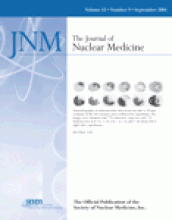Abstract
Recombinant human thyroid-stimulating hormone (rhTSH) recently was introduced as a radioiodine administration adjunct that avoids levothyroxine (LT-4) withdrawal and resultant hypothyroidism. The pharmacokinetics of 131I after rhTSH administration are known to differ from those after LT-4 withdrawal but are largely nondelineated in the radioiodine therapy setting. We therefore sought to calculate the red marrow absorbed dose of high therapeutic activities of 131I given after rhTSH administration to patients with metastatic or inoperable locally recurrent differentiated thyroid cancer. We also sought to evaluate the clinical and laboratory effects of this therapy on the bone marrow. Methods: Fourteen consecutive patients received in total 17 131I treatments (7.4 GBq). Blood and urine samples were obtained at fixed intervals, and their activities were measured in a well counter. Based on blood activity, renal clearance of the activity, and residence times in red marrow and the remainder of the body, the red marrow absorbed dose was calculated using the MIRD schema. Additionally, we monitored for potential hematologic toxicity and compared platelet counts before and 3 mo after treatment. Results: The mean ± SD absorbed dose per unit of administered 131I in the red marrow was 0.16 ± 0.07 mGy/MBq. The corresponding total red marrow absorbed dose was 1.15 ± 0.52 Gy (range, 0.28–1.91 Gy). In none of the patients was hematologic toxicity observed. The mean ± SD platelet count (n = 13 treatments) was 243 ± 62 × 109/L before treatment and 233 ± 87 × 109/L 3 mo later, a slight and statistically insignificant decrease. After rhTSH-aided administration of high activities of 131I, the bone marrow absorbed dose remained under 2 Gy, the level long considered the safety threshold for all radioiodine therapy. Conclusion: Our specific findings imply that when clinically warranted, rhTSH should allow an increase in the therapeutic radioiodine activity. Such an increase might improve efficacy while preserving safety and tolerability; this possibility should be assessed in further studies.
Footnotes
Received Nov. 13, 2003; revision accepted Mar. 10, 2004.
For correspondence or reprints contact: Bart de Keizer, Department of Nuclear Medicine, University Medical Center Utrecht, Room E02.222, Heidelberglaan 100, 3584 CX Utrecht, The Netherlands.
E-mail: b.dekeizer{at}azu.nl







